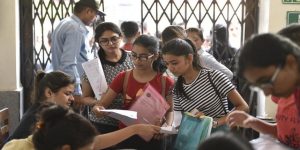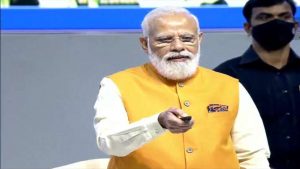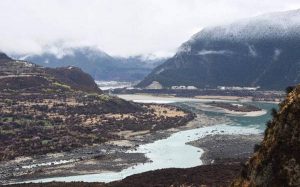Today Current Affairs: 3rd February 2022 for UPSC IAS exams, State PSC exams, SSC CGL, State SSC, RRB, Railways, Banking Exam & IBPS, etc
Table of Contents
Indian Coast Guard (ICG) Celebrated Its 46th Raising Day:

On 1st February 2022, Indian Coast Guard (ICG) celebrated its 46th Raising Day.
- ICG was established in August 1978 by the Coast Guard Act, 1978 as an independent Armed force of India.
- As the fourth largest Coast Guard in the world, it has played a significant role in securing the Indian coasts and enforcing regulations in the maritime zones of India.
ICG:
- It is an Armed Force, Search and Rescue and Maritime Law Enforcement agency under the Ministry of Defence.
- It is headquartered in New Delhi.
- The concept of forming ICG came into being after the 1971 war.
- The blueprint for a multidimensional Coast Guard was conceived by the visionary Rustamji Committee.
- For effective command and control, the Maritime Zones of India are divided into five Coast Guard Regions, namely, North-West, West, East, North-East and Andaman & Nicobar, with the respective Regional Headquarters located at Gandhinagar, Mumbai, Chennai, Kolkata and Port Blair. .
- One of the primary duties of the ICG is prevention of smuggling through maritime routes.
- It has jurisdiction over the territorial waters of India including contiguous zone and Exclusive Economic Zone (EEZ).
- It is responsible for marine environment protection in maritime zones of India and is coordinating authority for response to oil spills in Indian waters.
- It is also working in close coordination with Central and State agencies to put in place a robust coastal security mechanism.
- It is also collaborating with littoral countries to combat transnational maritime crimes and enhance maritime safety in its area of responsibility and in the Indian Ocean Region.
- Under SAGAR’ – Security and Growth for all in the Region & ‘Neighbourhood First’ policy, the ICG has nurtured professional relationships across oceans and established ties with countries in the Indian Ocean Region for Ocean Peacekeeping.
- The ICG has successfully averted major ecological disasters and emerged as the ‘First Responder’ in the region.
World Heritage Nomination 2022-2023:

The Union Ministry of Culture has nominated Sacred Ensembles of the Hoysalas temples for consideration as a World Heritage site for the year 2022-2023.
- The sacred ensembles of the Hoysalas, built in the 12th-13th centuries and represented by the three components of Belur, Halebid and Somnathapura in Karnataka.
- All these three Hoysala temples are protected monuments of the Archaeological Survey of India (ASI).
- The ‘Sacred Ensembles of the Hoysala’ have been on UNESCO’s Tentative list since 15th April, 2014 and stand testimony to the rich historical and cultural heritage of India.
- Earlier, the UNESCO’s World Heritage Centre (WHC) had agreed to publish Hindi descriptions of India’s UNESCO World Heritage Sites on the WHC website.
Chennakeshava Temple, Belur:
- Construction of the temple commenced in 1117 AD and took 103 years to complete.
- The temple is dedicated to Lord Vishnu known as Chennakesava, which means beautiful (chenna) Vishnu (Keshava).
- The richly sculptured exterior of the temple narrates scenes from the life of Vishnu and his reincarnations and the epics, Ramayana, and Mahabharata.
- However, some of the representations of Shiva are also included.
Hoysaleshwara Temple, Halebidu:
- The Hoysaleshwara temple at Halebidu is the most exemplary architectural ensemble of the Hoysalas extant today.
- Built in 1121CE during the reign of the Hoysala King, Vishnuvardhana Hoysaleshwara.
- The temple, dedicated to Shiva, was sponsored and built by wealthy citizens and merchants of Dorasamudra.
- The temple is most well-known for the more than 240 wall sculptures that run all along the outer wall.
- Halebid has a walled complex containing three Jaina basadi (temples) of the Hoysala period as well as a stepped well.
Keshava Temple, Somanathapura:
- The Keshava temple at Somanathapura is another magnificent Hoysala monument, perhaps the last.
- This is a breathtakingly beautiful Trikuta Temple dedicated to Lord Krishna in three forms – Janardhana, Keshava and Venugopala.
- Unfortunately, the main Keshava idol is missing, and the Janardhana and Venugopala idols are damaged.
Draft National Higher Educational Qualification Framework (NHEQF): UGC

The University Grants Commission (UGC) has released a Draft National Higher Educational Qualification Framework (NHEQF) as a part of the National Education Policy (NEP) 2020 to assess students at different levels.
- The NEP 2020 aims at making “India a global knowledge superpower”.
- Given the size of the higher education system and the diversity of institutions and programmes of study in India, the country needs to move towards developing a nationally accepted and internationally comparable and acceptable qualifications framework to facilitate transparency and comparability of higher education qualifications at all levels.
- The framework is not intended to promote a uniform curriculum or national common syllabus.
- The purpose is to bring up/elevate all HEIs (Higher Education Institutions) to a common level of benchmarking to ensure that all institutions are providing quality education.
- The draft framework has outlined several learning level “descriptors” or parameters based on which students can be assessed at every level.
- These parameters include generic learning outcomes, constitutional, ethical, and moral values, employment ready skills, entrepreneurship mindset, and application of knowledge and skills among others.
- The NHEQF has divided parameters into levels 5 to 10.
- Levels 1 to 4 cover the school education.
- The NHEQF level 5 represents learning outcomes appropriate to the first year (first two semesters) of the undergraduate programme of study, while Level 10 represents learning outcomes appropriate to the doctoral-level programme of study.
- The NHEQF envisages that students on completion of a programme of study must possess and demonstrate the expected graduate profile/attributes acquired.
- It also fixes the number of credits required to clear the different levels of the four-year undergraduate programme, postgraduate degrees and doctoral degrees.
- The NEP 2020 allows multiple entry and exits at the undergraduate level. It effectively means that students can exit after completing one year of undergraduate programme with a certificate, after two years with a diploma, after three years with a bachelor’s degree, or can complete four years and get an honours degree with a honours/research degree.
- A credit is a unit by which the coursework is measured.
Kerala Lokayukta Act, 1999 : Proposed Changes

The Kerala government has proposed to amend the Kerala Lokayukta Act, 1999 with an ordinance, a move that has drawn criticism from the opposition.
- The proposed ordinance envisages to limit the powers of the anti-corruption watchdog.
- The Kerala cabinet has recommended to the Governor that he promulgates the ordinance.
- The proposal sought to give the government powers to “either accept or reject the verdict of the Lokayukta, after giving an opportunity of being heard”.
- By this ordinance, the quasi-judicial institution will turn into a toothless advisory body, whose orders will no longer be binding on the government.
- Section 63 of the Lokpal and Lokayuktas Act, 2013 states: “Every state shall establish a body to be known as the Lokayukta for the State, if not so established, constituted or appointed, by a law made by the State Legislature”.
- It will be created to deal with complaints relating to corruption against certain public functionaries, within a period of one year from the date of commencement of this Act.
- However, the law is a mere framework, leaving it to the states to decide the specifics.
- Given that states have autonomy to frame their own laws, the Lokayukta’s powers vary from state to state on various aspects, such as tenure, and need of sanction to prosecute officials.
- When the 2013 Act was passed, Lokayuktas were already functioning in some states – including in Madhya Pradesh and Karnataka where they were very active.
- Following the Act and the intervention of the Supreme Court, most states have now set up a Lokayukta.
PM GatiShakti:

The Minister of Finance presented the Union Budget 2022-23.
- This section deals with proposals related to ‘PM GatiShakti’.
- PM GatiShakti National Master Plan for Multi-Modal Connectivity, launched in October 2021, is an initiative aimed at coordinated planning and execution of infrastructure projects. The objective is to bring down logistics costs.
- GatiShakti is a digital platform bringing development projects of 16 ministries, including railways and roadways, together for integrated planning and implementation.
- When launched, the GatiShakti scheme subsumed the Rs 110 lakh crore National Infrastructure Pipeline announced in 2019.
Focus Area for Budget 2022-23:
- Its scope will encompass the seven engines (Roads, Railways, Airports, Ports, Mass Transport, Waterways and Logistics Infrastructure).
- It will also include the infrastructure developed by the state governments as per the GatiShakti Master Plan.
- The touchstone of the Master Plan will be world-class modern infrastructure and logistics synergy among different modes of movement – both of people and goods – and location of projects.
Major Proposals for PM GatiShakti:
- PM GatiShakti Master Plan for Expressways will be formulated in 2022-23 to facilitate faster movement of people and goods.
- National Highways network to be expanded by 25,000 km in 2022-23. Rs. 20,000 crore to be mobilized for the expansion.
- The data exchange among all mode operators will be brought on Unified Logistics Interface Platform (ULIP), designed for Application Programming Interface (API).
- This will provide real time information to all stakeholders, lead to efficient movement of goods through different modes, and improve international competitiveness.
- Open-source mobility stack, for organizing seamless travel of passengers will also be facilitated.
- Contracts for implementation of Multimodal Logistics Parks at four locations through PPP (Public-Private Partnerships) mode will be awarded in 2022-23.
- Railways will develop new products and efficient logistics services for small farmers and Small and Medium Enterprises, besides taking the lead in integration of Postal and Railways networks to provide seamless solutions for movement of parcels.
- ‘One Station-One Product’ concept to help local businesses & supply chains.
- As a part of Atmanirbhar Bharat, 2,000 km of network will be brought under Kavach, the indigenous world-class technology for safety and capacity augmentation in 2022-23.
- 400 new-generation Vande Bharat Trains to be manufactured during the next three years.
- 100 PM GatiShakti Cargo Terminals for multimodal logistics facilities will be developed during the next three years.
- Mass Urban Transport including Connectivity to Railways :Innovative ways of financing and faster implementation will be encouraged for building metro systems of appropriate type at scale.
- Multimodal connectivity between mass urban transport and railway stations will be facilitated on priority.
- Parvatmala: National Ropeways Development Programme:
- As a preferred ecologically sustainable alternative to conventional roads in difficult hilly areas, National Ropeways Development Programme will be taken up on PPP mode.
- The aim is to improve connectivity and convenience for commuters, besides promoting tourism.
- This may also cover congested urban areas, where conventional mass transit systems are not feasible.
- Capacity Building for Infrastructure Projects:
- With technical support from the Capacity Building Commission, central ministries, state governments, and their infra-agencies will have their skills upgraded.
- This will ramp up capacity in planning, design, financing (including innovative ways), and implementation management of the PM GatiShakti infrastructure projects.
Energy Transition And Climate Action: Union Budget

The Union Minister for Finance & Corporate Affairs, Smt Nirmala Sitharaman tabled the Union Budget 2022-23 in Parliament.
- Additional allocation of Rs. 19,500 crore for Production Linked Incentive for manufacture of high efficiency solar modules to meet the goal of 280 GW of installed solar power by 2030.
- Five to seven per cent biomass pellets to be co-fired in thermal power plants:
- CO2 savings of 38 MMT annually,
- Extra income to farmers and job opportunities to locals,
- Help avoid stubble burning in agriculture fields.
- Four pilot projects to be set up for coal gasification and conversion of coal into chemicals for the industry
- Financial support to farmers belonging to Scheduled Castes and Scheduled Tribes, who want to take up agro-forestry.
Digital Rupee: Union Budget

Finance Minister Nirmala Sitharaman has announced the launch of the Digital Rupee — a central bank digital currency (CBDC) — 2022-23 onwards.
- The Reserve Bank of India will launch the CBDC from the upcoming financial year.
- A Central Bank Digital Currency (CBDC), or national digital currency, is simply the digital form of a country’s fiat currency.
- Instead of printing paper currency or minting coins, the central bank issues electronic tokens. This token value is backed by the full faith and credit of the government.
Four major use cases of CBDC in the Indian context:
- ‘Fit-for-purpose’ money used for social benefits and other targeted payments in a country. For such cases, the central bank can pay intended beneficiaries pre-programmed CBDC, which could be accepted only for a specific purpose.
- CBDCs could be used for faster cross-border remittance payments. International collaboration among the major economies of the world, including India, could help create the necessary infrastructure and arrangements for CBDC transfer and conversion.
- Payment instruments could be made available for payment transactions to be made via CBDC. Furthermore, universal access attributes of a CBDC could also include an offline payment functionality.
- Instant lending to micro, small, and medium enterprises (MSMEs) in India can be possible with the help of CBDC.
Project To Link Five Rivers:

Union Finance Minister Nirmala Sitharaman has proposed a project to link five rivers in India in her budget speech.
The rivers identified for linking are:
- Godavari-Krishna, Krishna-Pennar and Pennar-Cauvery, Damanganga-Pinjal and Par-Tapi-Narmada.
- Krishna, the fourth largest river in India, originates in Mahabaleshwar in Maharashtra and flows through Maharashtra, Karnataka, Telangana and Andhra Pradesh.
- Cauvery originates in Kodagu and flows through Karnataka and Tamil Nadu.
- Penna originates in Chikkaballapura and flows through Karnataka, Tamil Nadu and Andhra Pradesh.
- Godavari which is the third largest river in India originates in Nashik and flows through Maharashtra, Telangana, Andhra Pradesh, Chhattisgarh and Orissa.
- The Damanganga-Pinjal river linking aims to divert surplus water from the Damanganga basin to provide domestic water for Mumbai city.
- The Par-Tapi-Narmada project proposes to provide water to doubt-prone regions of Kutch and Saurashtra by diverting excess water from seven reservoirs in the Western Ghats in North Maharashtra and south Gujarat.
Nal Se Jal’ Yojana:Union Budget

An allocation of Rs 60,000 crore has been made to cover 3.8 crore households in 2022-23 under Har Ghar, Nal Se Jal scheme.
- Nal Se Jal Yojana Launched in 2019.
- Nodal Agency: Ministry of Jal Shakti
- Aim: To provide piped drinking water to every rural home by 2024
- It is a component of the government’s Jal Jivan Mission.
- The scheme is based on a unique model where paani samitis (water committee) comprising villagers will decide what they will pay for the water they consume.
- The tariff they fix will not be the same for everyone in the village. Those who have large households will pay more, while poor households or households where there is no earning member, will be exempted.
- According to a 2018 NITI Aayog report, 600 million Indians face high to extreme water stress and about two lakh people die every year due to inadequate access to safe water.
- By 2030, the country’s water demand is projected to be twice the available supply, implying severe water scarcity for hundreds of millions of people and an eventual ~6% loss in the country’s GDP.
- Studies also show that 84% of rural homes have no access to piped water, with more than 70% of the country’s water contaminated.
About Jal Jeevan Mission:
- JJM envisages supply of 55 litres of water per person per day to every rural household through Functional Household Tap Connections (FHTC) by 2024.
- It is under the Ministry of Jal Shakti.
- It was launched in 2019
- The Mission is based on a community approach to water and includes extensive Information, Education and Communication as a key component of the mission.
- JJM looks to create a jan andolan for water, thereby making it everyone’s priority.
- The fund sharing pattern between the Centre and states is 90:10 for Himalayan and North-Eastern States, 50:50 for other states, and 100% for Union Territories.
Contempt Of Court:

Chief Justice of India N.V. Ramana has agreed to immediately list for hearing a petition to initiate contempt action against Haryana authorities for not reining in ‘hooligans’ who have created an ‘atmosphere of communal hatred and terror’ for worshippers offering Friday prayers in Gurugram.
- The petition condemned the inaction of the Haryana officials in violation of a Supreme Court judgment of 2018, which mandated that authorities should not be either silent spectators or tolerate communal violence and should use the law against hate crimes.
- While the basic idea of a contempt law is to punish those who do not respect the orders of the courts, in the Indian context, contempt is also used to punish speech that lowers the dignity of the court and interferes with the administration of justice.
Contempt of court can be of two kinds:
- Civil, that is the willful disobedience of a court order or judgment or willful breach of an undertaking given to a court.
- Criminal, that is written or spoken words or any act that scandalises the court or lowers its authority or prejudices or interferes with the due course of a judicial proceeding or interferes/obstructs the administration of justice.
- Article 129 and 215 of the Constitution of India empowers the Supreme Court and High Court respectively to punish people for their respective contempt.
- Section 10 of The Contempt of Courts Act of 1971 defines the power of the High Court to punish contempts of its subordinate courts.
- The Constitution also includes contempt of court as a reasonable restriction to the freedom of speech and expression under Article 19, along with elements like public order and defamation.




